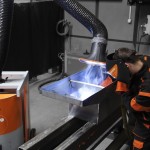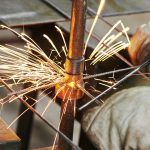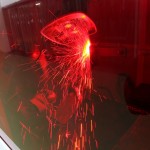WIG welding: “Clean” process with underestimated health risk
It is deemed a “clean” welding process creating only little welding fumes and is therefore often underestimated: WIG welding. The process harbors health risks which should not be underestimated. Welders are exposed to nitrogen oxides, radioactivity and ozone in particular. For this reason, appropriate health and safety measures for prevention are necessary.
WIG welding is a popular technique for high quality welding work – e.g. for pipelines, furniture or art objects. Compared with MIG / MAG welding, it is significantly slower in practice, but it creates a clean and uniform welding seam. A special feature of WIG welding is the use of a tungsten electrode which does not melt down during the process. This creates only minimal welding spatter and generates comparatively low quantities of welding fumes.
Nevertheless, welders should not be fooled by the small amount of welding fumes: Ozone and nitrous gases (nitrogen oxides) are generated during WIG welding. Ozone is classified as carcinogenic according to TRGS 905 [Technical Rules for Hazardous Substances]. It is formed by UV radiation from the oxygen in the air. UV radiation is generated by the arc – the larger the current, the greater the radiation. The ozone values are particularly high for aluminum-silicon alloys and pure aluminum. Since the UV radiation goes beyond the immediate welding area, ozone is also generated outside the arc area and protective gases.
Watch out for reflections
In addition, it is important not to underestimate reflected rays. Black material such as iron or structural steel (e.g. S235JR+AR) is welded in metalworking shops. Ozone generated during welding disintegrates quicker in the smoke particles and other dusts generated during MIG and MAG welding, e.g. during grinding. Furthermore, the ozone radiation is absorbed faster by the dark surfaces of the workpieces made from black material. The situation is different for WIG welding: The workpieces processed in this process are normally made from aluminum or stainless steel. Its metallic shiny surfaces reflect UV radiation, which means that ozone may form even at some distance from the welding location.
 The reflections are also favored by the low smoke generation during WIG welding. The less smoke is generated, the more UV radiation can spread which in turn leads to more ozone formation. In addition, ozone is an unstable gas: Smoke or dust would promote its decomposition to oxygen which is not the case if the smoke development is low. Therefore, it is important to not only use point suction to capture the particles shaped welding fumes and ozone at the source. Supporting hall ventilation prevents the spread of ozone in the factory hall.
The reflections are also favored by the low smoke generation during WIG welding. The less smoke is generated, the more UV radiation can spread which in turn leads to more ozone formation. In addition, ozone is an unstable gas: Smoke or dust would promote its decomposition to oxygen which is not the case if the smoke development is low. Therefore, it is important to not only use point suction to capture the particles shaped welding fumes and ozone at the source. Supporting hall ventilation prevents the spread of ozone in the factory hall.
The electrode makes the difference
If a thorium oxide containing tungsten electrode is used during WIG welding, specifically when working with aluminum materials, then the welder is exposed to radioactive radiation due to smoke inhalation. How strong that radiation exposure is, depends on the welding procedure, i.e. whether it is done with DC or AC. In WIG welding with DC, you can assume that the annual threshold value of 6 milliSievert (mSv) is not exceeded by inhaling thorium oxide. If welding is done with AC, however, e.g. when using aluminum materials, then it is likely that the limit is exceeded. The consequence may be damage to the periosteum, bone marrow, liver and lung. In general, we recommend avoiding thorium oxide containing tungsten electrodes and to use equivalent additives such as cerium or lanthanum. If this is not possible for technical reasons, then extraction at source is required with IFA tested filter devices (W3) or if grinding the electrodes using dust extractors of dust class H1 (refer to BGI 746).
Last but not least, there is danger due to carcinogenic hazardous substances during WIG welding, since chrome-nickel steel is frequently welded using this process. This produces nickel oxide and chrome(VI)-compounds, which can irritate the respiratory tract and cause damage to the nervous system. An effective work protection by using powerful extraction systems and filtration devices is therefore essential.





